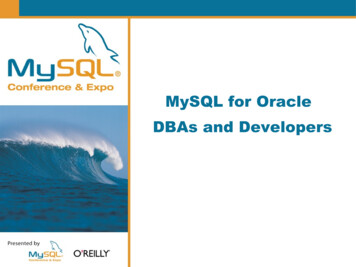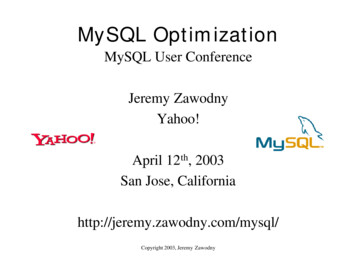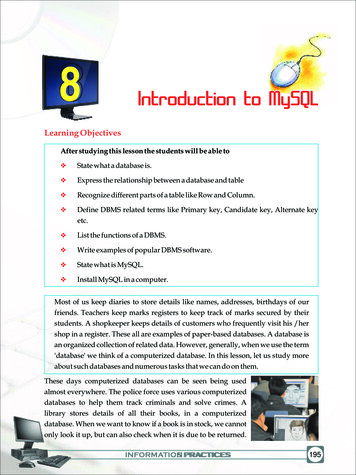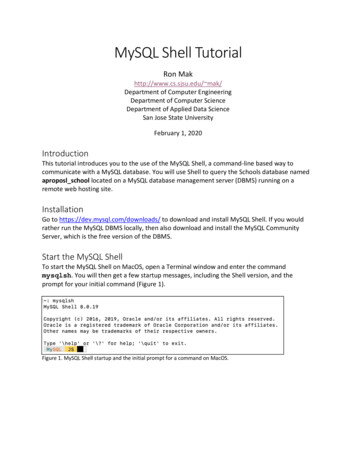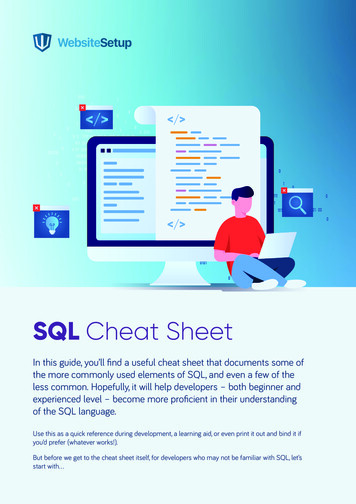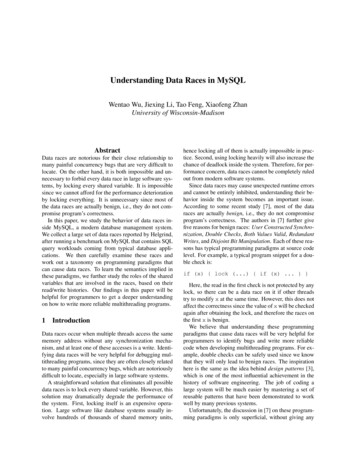
Transcription
Understanding Data Races in MySQLWentao Wu, Jiexing Li, Tao Feng, Xiaofeng ZhanUniversity of Wisconsin-MadisonAbstractData races are notorious for their close relationship tomany painful concurrency bugs that are very difficult tolocate. On the other hand, it is both impossible and unnecessary to forbid every data race in large software systems, by locking every shared variable. It is impossiblesince we cannot afford for the performance deteriorationby locking everything. It is unnecessary since most ofthe data races are actually benign, i.e., they do not compromise program’s correctness.In this paper, we study the behavior of data races inside MySQL, a modern database management system.We collect a large set of data races reported by Helgrind,after running a benchmark on MySQL that contains SQLquery workloads coming from typical database applications. We then carefully examine these races andwork out a taxonomy on programming paradigms thatcan cause data races. To learn the semantics implied inthese paradigms, we further study the roles of the sharedvariables that are involved in the races, based on theirread/write histories. Our findings in this paper will behelpful for programmers to get a deeper understandingon how to write more reliable multithreading programs.1IntroductionData races occur when multiple threads access the samememory address without any synchronization mechanism, and at least one of these accesses is a write. Identifying data races will be very helpful for debugging multithreading programs, since they are often closely relatedto many painful concurrency bugs, which are notoriouslydifficult to locate, especially in large software systems.A straightforward solution that eliminates all possibledata races is to lock every shared variable. However, thissolution may dramatically degrade the performance ofthe system. First, locking itself is an expensive operation. Large software like database systems usually involve hundreds of thousands of shared memory units,hence locking all of them is actually impossible in practice. Second, using locking heavily will also increase thechance of deadlock inside the system. Therefore, for performance concern, data races cannot be completely ruledout from modern software systems.Since data races may cause unexpected runtime errorsand cannot be entirely inhibited, understanding their behavior inside the system becomes an important issue.According to some recent study [7], most of the dataraces are actually benign, i.e., they do not compromiseprogram’s correctness. The authors in [7] further givefive reasons for benign races: User Constructed Synchronization, Double Checks, Both Values Valid, RedundantWrites, and Disjoint Bit Manipulation. Each of these reasons has typical programming paradigms at source codelevel. For example, a typical program snippet for a double check is:if (x) { lock (.) { if (x) . } }Here, the read in the first check is not protected by anylock, so there can be a data race on it if other threadstry to modify x at the same time. However, this does notaffect the correctness since the value of x will be checkedagain after obtaining the lock, and therefore the races onthe first x is benign.We believe that understanding these programmingparadigms that cause data races will be very helpful forprogrammers to identify bugs and write more reliablecode when developing multithreading programs. For example, double checks can be safely used since we knowthat they will only lead to benign races. The inspirationhere is the same as the idea behind design patterns [3],which is one of the most influential achievement in thehistory of software engineering. The job of coding alarge system will be much easier by mastering a set ofreusable patterns that have been demonstrated to workwell by many previous systems.Unfortunately, the discussion in [7] on these programming paradigms is only superficial, without giving any
2.1more example patterns except for the one on doublecheck, as described above. Meanwhile, to the best ofour knowledge, we are also not aware of any previouswork that tries to develop such a set of programmingparadigms, which we think will be quite useful.In this paper, we report our effort towards building aset of common programming paradigms that can causedata races. We systematically study the data races occurring in a mature software called MySQL1 , and then workout a taxonomy of programming paradigms that willcause data races. MySQL is an open-source databasemanagement system that has been developed for morethan 15 years. We choose MySQL as our target systemdue to the following four reasons:MySQL is an open-source database management system.Figure 15 shows the architecture of MySQL. Basically,MySQL server uses a layered architecture. Clients sendSQL queries to the server via standard interface such asODBC and JDBC. A SQL query will first be parsed andthen optimized to generate a query plan, which is a treelike structure with each node representing a relational operator. The plan will then be executed by the executor,which simply runs each operator by traversing the tree ina bottom-up manner.The most important module of MySQL server is itsstorage engine. Starting from 5.5, the version we use,MySQL adopts InnoDB as its default storage engine,which provides standard ACID-compliant transactionfeatures. Prior to MySQL 5.5, MyISAM is used by default, which does not support transactions. The storage engine manages all the important resources in adatabase that will be accessed by multiple queries, including buffer pages, indexes, locks, logs, and files. Notsurprisingly, this is the module where most of the dataraces are involved. Database systems are typical large software inwhich concurrency mechanisms are heavily used togain high performance and throughput. Unlike another well-known open-source databasesystem PostgreSQL2 , pthreads3 are intensively usedinside MySQL, which makes race detection toolslike Helgrind4 workable. MySQL is sufficiently large and complex for covering a complete set of common programmingparadigms, which can be thought of as ubiquitousin other multithreading programs.2.2HelgrindHelgrind is a tool included in the Valgrind6 toolkit thatcan detect data races when running a binary program.The latest version (3.6.1) we use adopts an race detection algorithm based on Lamport’s happens-before relation [5]. Simply speaking, it defines an ordering on a setof asynchronous events, and reports races on the caseswhen this ordering is violated. Compared with lockset [9] based algorithms, happens-before algorithms canreport fewer false positives and hence can be more accurate, although they will also miss certain kinds of races.To implement the happens-before algorithm, Helgrindneeds to intercept each call to the events it concerns.However, it can only intercept standard pthread calls. Asa result, Helgrind is not aware of any user constructedsynchronization mechanism, and will report a race in thissituation that will not actually happen. Since MySQL has been developed for many years,there should be very few bugs, and most of theraces are expected to be benign. Therefore wehave a great chance to learn which programmingparadigms are good.The rest of the paper is organized as follows. Section 2 provides background information on MySQL andHelgrind. Section 3 describes our methods on obtainingand analyzing data races in MySQL. Section 4 presentsour results, with focus on the taxonomy of programming paradigms we found through our analysis to thedata races. To better understand the semantics implied bythese paradigms, in Section 5, we further study the rolesof those shared variables that are involved in the races.We discuss related work in Section 6, and conclude thepaper in Section 7.2MySQL3MethodOur goal is to capture a large set of data races that canappear when running MySQL. To achieve this, we designa benchmark consisting of different kinds of SQL queryworkloads. We admit here that there is no way for usto know whether the set of races obtained is complete.However, we take care in designing our benchmark soBackgroundIn this section, we briefly introduce some backgroundinformation about MySQL and Helgrind.1 http://www.mysql.com/2 http://www.postgresql.org/5 From torageoverview.html6 http://www.valgrind.org/3 http://en.wikipedia.org/wiki/POSIXThreads4 http://valgrind.org/docs/manual/hg-manual.html2
Figure 1: Architecture of MySQLthat it contains typical workloads that can raise in thedaily use of a database. Therefore we believe that thedata races triggered by this benchmark should containmost of, if not all, typical data races inside the databasesystem.In this section, we first present our benchmark queriesin Section 3.1. Then, in Section 3.2, we outline the stepsof our method.3.1ple read/write queries that are randomly generatedbased on the TPC-H schema, which only update tables. A simple read query is a SELECT statementthat involves a single table, while a simple writequery is an UPDATE, INSERT, or DELETE statement that involves a single table. W2. The second workload consists a set of simple read/write queries that are randomly generatedbased on the TPC-H schema, which update both tables and indexes.Benchmark Queries W3. The third workload consists a set of TPC-Hqueries. TPC-H benchmark contains typical online analytical processing (OLAP) queries whichare read-intensive, involving complex joins acrossmultiple tables.We create two databases with respect to the schemasspecified in the TPC-H7 and TPC-C8 benchmarks, respectively9 . We then load 1GB data into each database,by using the dbgen tool that is freely available on theTPC website.We design a benchmark including four different workloads: W1. W4. The fourth workload consists a set of TPCC queries. TPC-C benchmark contains typical online transaction processing (OLTP) queries whichare write-intensive.The first workload consists a set of sim-7 http://www.tpc.org/tpch/Since access to the data in the database is eithervia file scan or index, workloads W1 and W2 are expected to cover typical access paths inside the database.8 http://www.tpc.org/tpcc/9 Seethe TPC-H and TPC-C specifications that can be freely downloaded from their websites for the description of database schemas.3
Meanwhile, workloads W3 and W4 come from standardbenchmarks that emulate typical workloads that can occur in real application scenarios, and they can cover mostof the races that will actually raise during the normal execution of the database server.3.2will be many, since programming paradigms are directlyrelated to the semantics implied by the programmer. It isnot very convincing that the programmer will use somecode pattern that can only cause data races on heavyworkloads but never cause data races on low workloads.Nonetheless, it is still interesting to investigate the difference when heavier workloads with more clients and morequeries are issued, by using a more powerful computer.StepsOur study on data races then proceed in the followingthree steps:41. We use Helgrind to run the MySQL server, whichcan record the data races during the execution of theserver.ResultsWe present the results of our study in this Section. Section 4.1 summarizes the distribution of data races acrossdifferent modules inside MySQL server. Section 4.2gives a taxonomy on the programming paradigms thatcan cause data races, based on the races we collect.2. We run each workload respectively: For W1 and W2, we concurrently run twoclients, with each sending 10 SQL queries tothe server. We also vary the percentage of readqueries in each workload and rerun the clientsto try to prob new data races.4.1General StatisticsFigure 2 shows the distribution of data races on workloads W1 and W2. We measure the numbers by varyingthe percentage of read queries in 0%, 25%, 50%, 75%,and 100%, respectively. We also measure the number ofdata races when no query is issued to the database (denoted by ’No query’ in the plot).We observe three interesting phenomena: For W3, we pick up 3 queries (see Appendix A) from the 22 queries available in thestandard TPC-H benchmark. We then concurrently run two clients, with each sending these3 queries to the server. For W4, we use a tool dbt210 that can automatically generate TPC-C queries and run themon top of MySQL. We slightly modify the toolso that MySQL server could be run under theinstrumentation of Helgrind. The commandwe used to run the tool is:run workload.sh -c 2 -d 1200 -w 2 The distribution is quite uneven. Modules suchas buffer manager (’/storage/innobase/buf’), filemanager (’/storage/innobase/fil’), lock manager(’/storage/innobase/lock’), and log manager (’/storage/innobase/log’) include most of the data racesdetected since they are the key modules that manage shared resources inside the storage engine. The peak number of races does not occur whenthere are pure read or pure write queries, but occurs at a certain mixture of read and write queries.In our test, the maximum number of races (1387)on W1 occurs when there are 25% of read queries,while the maximum number of races (1552) on W2occurs when there are 50% of read queries., which means we run 2 clients for 1200 seconds on 2 warehouses.3. We collect all the data races recorded by Helgrind,and manually analyze and classify them into different categories.As noted above, we use relatively lightweight instances for each workload. The reason is twofold. First,running MySQL under Helgrind is much slower, andwe cannot afford heavier workloads with the computer11we used in our test. Second, we are only interested indata races that exhibit different programming paradigms.Running heavier workloads may raise more data races,but whether they can come up with more types of programming paradigms is unclear. We do not believe there W2 raises more data races than W1, since it involvesmore index updates. This can be confirmed by theslight increase on the number of races in the indexmodule (’storage/innobase/btr’). Since we only uselightweight instances of the workloads, the difference is not very significant. We can expect moreraces on indexes by using heavier workloads.Figure 3 further shows the distribution of data raceswhen running workloads W3 and W4. Since W3 is readintensive, we also compare the distribution with that inW1 and W2 when there are pure reads. As can be seen,10 /11 We use a laptop configured with 2.1 GHz Intel Core Dual CPU and2GB memory.4
W3 raises much more races overall. However, most ofthe new data races appear in the modules of buffer manager (’/storage/innobase/buf’) and synchronization control (’/storage/innobase/sync’). This is expected sinceTPC-H queries involve heavy table scans that incur intensive competition on using the buffer. For W4, sinceit is write-intensive, we compare its distribution withthat in W1 and W2 when there are pure writes, and wecan observe similar variations as well. Apart from thehuge number of races in the buffer manager and synchronization control modules, there are also considerablenumber of races in the log management module (’/storage/innobase/log’), which are not observable under readintensive environment since only writes to the databaseshould be recorded for recovery purpose on system crash.4.2ber of races reported are due to user constructed synchronization mechanisms. Strictly speaking, the racesreported here should be categorized as false positives,since there are actually no races. However, to be familiar with this kind of programming paradigms can helpprogrammers identify these fake races more quickly.The pseudo code description looks like:Thread 1:mutex enter(&mutex);update X;mutex exit(&mutex);Thread 2:mutex enter(&mutex);update X or read X;mutex exit(&mutex);Taxonomy of Programming ParadigmsThere is actually no race here, since every accessto the X is protected by user defined synchronizationprimitives mutex enter() and mutex exit().Unfortunately, Helgrind cannot recognize these functions for synchronization purpose, and will report dataraces on X.As discussed in Section 1, previous study in [7] revealsthat benign data races are related to different programming paradigms. We carefully examine the data racesreported in MySQL, and present our findings in this section. In summary, we identify four typical programmingparadigms: User Constructed Synchronization, DisjointBit Manipulation, Repeated Checks, and ApproximatedValues. The first two are already described in [7], whilethe last two can roughly fall into the category of BothValues are Valid, also mentioned in [7]. However, wefeel that the category of Both Values are Valid is both toobig and too vague, so we want to break it into finer subcategories. There are two other categories in [7] that wehave not found their way in MySQL: Redundant Writesand Double Checks. Redundant Writes is admitted bythe authors of [7] as another subcategory of Both Valuesare Valid, while Double Checks has been illustrated inSection 1. To some extent, we think that the absenceof these two categories makes sense, since these twoparadigms are actually weird and should not appear ina well-formed program. For example, the first check inthe example of Double Checks shown in Section 1 seemstotally redundant.In the following discussion, for each paradigm, wewill first illustrate it with pseudo code, and then presentseveral case studies to show how it is used insideMySQL.4.2.1Case Study12 :Thread 1:fil flush file spaces(){mutex enter(&fil system- mutex);n space ids UT LIST GET LEN(fil system- unflushed spaces);mutex exit(&fil system- mutex);}Thread 2:fil flush(){mutex enter(&fil system- mutex);UT LIST REMOVE(unflushed spaces,fil system- unflushed spaces,space);mutex exit(&fil system- mutex);}In this code snippet, both threads access the variablefil system- unflushed spaces, which is protected by mutex enter and mutex exit. However,data races are still reported by Helgrind. Similar casesappear in MySQL for many times. Interestingly, thereare even data races reported inside mutex enter()and mutex exit(). See Appendix B for a detailedstudy on the implementation of these two functions.User Constructed SynchronizationFor portability reasons, except for using standard pthreadfunctions, large multithreading systems like MySQL willalso implement its own functions for synchronizationpurpose. These synchronization mechanisms are unaware of by race detection tools like Helgrind that arebased on intercepting pthread calls. Therefore, a num-12 See5Appendix D for the locations where the functions are defined.
4.2.2Disjoint Bit Manipulation4.2.3Repeated ChecksThe pseudo code description looks like:This type of programming paradigms is related to dataraces reported on a shared variable that is a complexstructure with multiple fields. Different threads involvedin the races usually operate on different fields inside thestructure. The pseudo code description looks like:A a;Thread 1:Loop:if (condition on X) {do something;} else {do something else;goto Loop;}Thread 1:write a- X;Thread 2:X new value;Thread 2:read or write a- Y;Clearly, there is a race here. In Thread 1, variable X isread and the condition containing X is evaluated. Thread2, at the same time, is going to update X. Supposethe condition can only be triggered after X is assignedthe new value. The race here then will not affect thecorrectness of the program, since Thread 1 will keep onchecking the condition until it becomes valid. The onlyside effect is that Thread 1 may waste some time onchecking X again if Thread 2 is preempted by Thread 1before X is updated.typedef struct { X; Y; } A;However, data races are reported by Helgrind on thiskind of programming paradigms, since Helgrind regardsthe structure A as an atomic unit. In other words, accessto any field of A is treated by Helgrind as equivalentto access to A as a whole. Clearly, such data races aresheerly benign.Case Study:Case Study 1:Thread 1:srv release threads(){.slot- suspended FALSE;.}Thread 1:buf pool check no pending io(void){bool ret TRUE;if (buf pool- n pend reads) {ret FALSE;}return ret;}Thread 2:srv thread has reserved slot(){mutex enter(&kernel mutex);if(slot- in use &&slot- type type){occupy the reserved slot;}mutex exit(&kernel mutex);}Thread 2:buf page io complete(buf page t*bpage){.processing read requestsbuf pool- n pend reads--;.}In the above example, slot- suspended iswritten by Thread 1 and slot- in use andslot- type are read by Thread 2, which raises adata race reported by Helgrind. If Thread 1 is preempted before setting slot- suspended as FALSE,Thread 2 is not affected since it does not need to referto slot- suspended during its execution. Note that&kernel mutex protection is used in Thread 2 to prevent multiple threads occupying the same slot.In the above code snippet, Thread 1 checks whetherthere is pending read requests while Thread 2 willprocess them if any. Consider the following case. InThread 2, buf pool- n pend reads is initializedto be 1 and will become 0 after the decrement. Now,suppose that Thread 2 is preempted by Thread 1 beforethe decrement is done. In this situation, Thread 1 willreturn TRUE, indicating that there are still pending read6
requests. The consequence (not shown here) is that,MySQL will try to process pending read requests in thebuffer again, resulting in finding that there is actually nosuch requests. Although this behavior leads to wastingtime on unnecessary checks, the correctness is notaffected.others may be used by higher-level modules such as thequery optimizer. No matter which purpose, the valuesrecorded in these variables do not need to be perfectlyprecise, and hence it is not worthwhile to use expensivesynchronization methods to protect them.The pseudo code description looks like:Case Study 2:Thread 1:update X;Thread 1:logs empty and mark files at shutdown(void){.srv shutdown state SRV SHUTDOWN CLEANUP;.}Thread 2:read or print X;The key difference here from the case of RepeatedChecks is that the value of X will never be used todetermine the control flow of the program.Case Study 1:Thread 2:srv lock timeout thread(){loop:.if (srv shutdown state SRV SHUTDOWN CLEANUP){goto exit func;}goto loop;exit func:.}Thread 1:btr cur search to nth level(){.btr cur n non sea ;.}Thread 2:srv refresh innodb monitor stats(void){.btr cur n non sea old btr cur n non sea;.}As suggested by the function names, Thread 1 marksthe state of server to be SHUTDOWN, and Thread 2 checkswhether a thread has exceeded the timeout when waiting for a lock. If Thread 1 is executed before Thread2, then Thread 2 will execute exit func. However,if Thread 1 is preempted by Thread 2 before setting thesrv shutdown state, then Thread 2 will not execute exit func immediately. Instead, it keeps onchecking the value of srv shutdown sate, untilThread 1 successfully does the assignment. In this case,the execution of exit func is delayed. However, itdoes not affect the correctness since exit func willfinally be executed.In this example, Thread 1 searches a B-tree index andpositions a tree cursor at a given level. The variablebtr cur n non sea is used to record the numberof non-hashing searches down the B-tree. Thread 2stores the current statistic item to another location. Bothvariables in Thread 2 are used to calculate per-secondaverage statistics. The statistics will be displayed on themonitor for users’ reference and will not be involved inany critical functionality of MySQL.Case Study 2:4.2.4Approximated ValuesThread 1:os file read func(ulint n){.os bytes read since printout n;.}Not every variable requires an accurate value all the timeduring the execution of the program. For example, largedatabase systems like MySQL keep many variables thatare only used for statistical purpose. There are manydifferent usages of these statistics. Some are just runtimeparameters indicating certain system states such as thenumber of reads/writes on buffer pages, which are onlyused for monitoring and administrative purpose. SomeThread 2:os aio refresh stats(void){7
To further understand the semantics implied by theseparadigms, we investigate the shared variables that areinvolved in the reported races. In this paper, we only focus on classifying these shared variables based on theirread/write histories. Basically, any shared variable withdata races on it can fall into one of the following fivecategories:.os bytes read since printout 0;.}In this example, the variable in Thread 1 records thenumber of bytes that are read since the last printout,and Thread 2 resets the statistic to be 0. The functionos aio refresh stats(void) is called inanother function periodically, protected by the mutex&srv innodb monitor mutex. This means that,in the above case, Thread 2 can preempt Thread 1 butThread 1 cannot preempt Thread 2. The consequence ofthis preemption is that Thread 1 may not count the mostrecent number of the bytes read. Since the statistic is notcritical, the deviation can be ignored. Write-Only: the variable is only written but neverread. Single-Reader-Single-Writer: the variable is readby one thread and written by another thread. Single-Reader-Multiple-Writer: the variable is readby only one thread but written by multiple otherthreads. Multiple-Reader-Single-Writer: the variable is readby multiple threads but written by only one thread.Case Study 3:Thread 1:trx assign rseg(){rseg trx sys- latest rseg;.} Multiple-Reader-Multiple-Writer: the variable isboth read and written by multiple threads.Different access histories imply different functionalities of the variable. A write-only variable sounds weird,since its value will never be read and therefore the dataraces on it can be totally ignored. Theoretically, it seemsthat such a variable should never exist in a program.However, in practice, there is some special reason for using write-only variables, as we shall see in Section 5.1.Single-reader-single-writer variables seem only havinglocal interest, which usually are used inside a single module. Single-reader-multiple-writer and multiple-readersingle-writer variables are of greater interest, which usually are related to certain kind of system functionalities. Finally, multiple-reader-multiple-writer variablesusually are related to functionalities that involve multiple modules of the system.We modify Helgrind so that it can also record the access history of each shared variable. Appendix C describes some details on the modification we made to Helgrind. Figure 4 further shows the distributions of sharedvariables across different categories on workloads W1and W2. The distributions are similar. Not surprisingly, most of the shared variables are multiple-readermultiple-writer ones. However, there are also considerable number of variables that fall into other categories.In the rest of this section, we presents some typical examples in each category of roles of shared variables.Thread 2:trx assign rseg(){.rseg UT LIST GET NEXT(rseg list, rseg);.trx sys- latest rseg rseg;}In this example, the first and last statement in the samefunction cause a data race. The function assigns a rollback segment to a transaction in a round-robin fashion.All the rollback segments for a transaction are kept ina linked list. The first statement loads the latest rollback segment to rseg, then it goes to the segment listto search for the next segment following the current oneand update rseg. The last statement assigns rseg tothe latest rollback segment. If Thread 2 is preemptedbefore completing the last statement, the latest rollbacksegment will not be the latest one, but an older version.However, the rollback segment is still updated in a roundrobin fashion, and the only effect from this race is that theinterleaving order on threads may be slightly changed.Nonetheless, this will not affect the correctness of theprogram.5.15Role of Shared VariablesWrite-OnlyA typical example of write-only variables is the variablerec dummy declared at line 145 of rem0rec.c13 .The study presented in Section 4.2 mainly focuses moreon the syntactic level of the programming paradigms.13 MySQL85.5.11
5.3A typical example of single-reader-multiple-writer variables is the variable shutdown in progress declared at line 368 of mysqld.cc. This variable is introduced to indicate whether the server should be shutdown. This variable is initialized to be false, and multiple threads can set it to be true if there is some severeevent so that the server needs to be shut down. Only theshutdown handler will check the state of this variable tosee whether the server should be shut down.(a) Distribution on W1.5.4Multiple-Reader-Single-WriterA typical example of multiple-reader-single-writervariables is the variable srv shutdown statedeclared at line 118 of srv0start.c. This variable canonly be changed by the main thread during the shutdownprocedure of the server. Meanwhile, the value of thisvariable will climb from SRV SHUTDOWN NONEto SRV SHUTDOWN CLEANUP and then toSRV SHUTDOWN LAST PHASE, which indicatedifferent stages in the shutdown process. Other threadswill decide their own behavior on cleanup like releasingthe locks that are held, by monitoring the value ofsrv shutdown state.(b) Distribution on W2.Figure 4: Distribution of shared variablesThe two statements that use this variable are:rec dummy sum;, appearing at line 1554 and1617, respectively, where data races are reported.The purpose for introducing this variable is to try tofool the compiler so that it will not do unexpected optimization to the code. Here, sum is a local variable thatis never read. So a smart compiler will do an optimization by removing sum from the program, since it wastesCPU cycles for writing a local variable that is never read.However, the assignment statements (at line 1537 and1600) t
MySQL is an open-source database management system. Figure 15 shows the architecture of MySQL. Basically, MySQL server uses a layered architecture. Clients send SQL queries to the server via standard interface s


